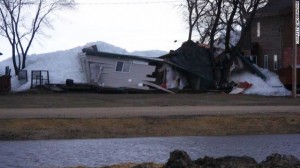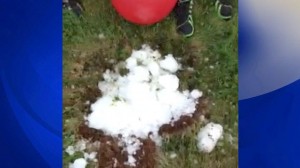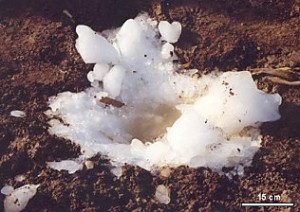On May 8, 2013 in Gray, Tennessee, a 50 lb chunk of ICE the size of a beach ball fell out of the sky and hit the ground like a meteorite.
Labeled a megacryometeor, the ice ball forms under unusual atmospheric conditions. The strangest thing about this event, however, is there were no thunderstorms in the area, and this mega-hailstone fell from an empty sky. More than 50 megacryometeors have been recorded since the year 2000.
Four days later on May 12, 2013, a powerful 30′ wall of ICE pushed off the Great Lakes onto the shore in Manitoba, Canada, and a wall of ICE also destroyed homes in Minnesota offshore Mille Lacs Lake.
Both events were labeled an ice tsunami, and blamed on high winds blowing the shallow layers of melting ice off the lakes. Ice tsunamis are more

An ice tsunami.prone to happen after a late season cold spell disturbs the Springtime melting ice on the lakes.
prone to happen after a late season cold spell disturbs the Springtime melting ice on the lakes.
Two days after that on May 14, 2013, lesser-spotted mammatus clouds (bubble clouds) were spotted over Shropshire, Great Britain. The explanation is that a storm with a high level of warm water vapor forms short-lived bubble clouds.
The odd thing about mammatus clouds is the fact that they are packed full of ICE and rain.
Witnessing Earth Changes
One thing we know for sure is that the Earth is very different today, and the odd events we are witnessing are not going away any time soon. The Earth is getting older; it’s getting hotter; its rotation is unstable and the axis is wobbling more than it has in millennia Events like megacryometeors, ice tsunamis, and bubble clouds are occurring more and more. The wisest thing we can do is take them seriously, understand why they are occurring more often, and make sure our living conditions and power grids are redesigned to out-stand these Earth changes.
Heads up – you never know when a megacryometeor might fall in YOUR backyard.


